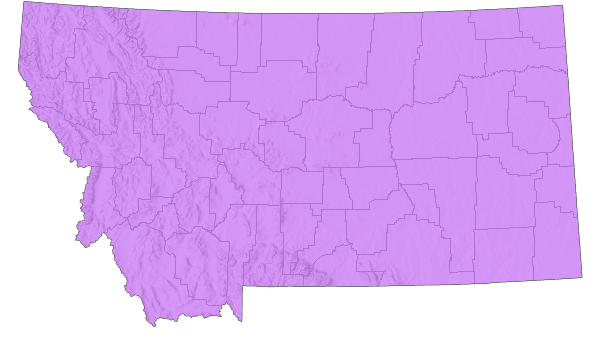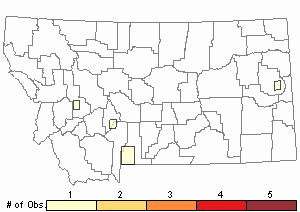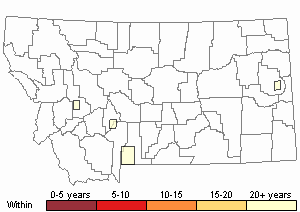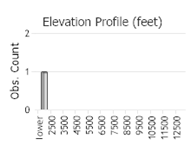View in other NatureServe Network Field Guides
NatureServe
Montana
Utah
Wyoming
Idaho
Wisconsin
British Columbia
South Carolina
Yukon
California
New York
Kennicott's Spur-throat Grasshopper - Melanoplus kennicotti
General Description
The following comes from Hebard (1928), Brooks (1958), Helfer (1971), Vickery and Kevan (1985), McDaniel (1987), and Pfadt (2002). A small, dark gray species with body patterns contrasting with pale or tannish gray areas, and sometimes with a greenish tinge. The wings (tegmina) are long reaching approximately to the abdominal tip. The outer face of the hind femur is yellow ventrally with obvious dark crossbands on the upper half. The hind tibia can be buff gray-brown or blue.
Phenology
Eggs overwinter in the ground and hatch in late spring, around the first week of June. It is among the early hatching Melanoplus species in montane and grassland environments. Adults have been collected in July and August (Pfadt 2002, and Vickery and Kevan 1985).
Diagnostic Characteristics
Taken from Hebard (1928), Brooks (1958), Helfer (1971), Vickery and Kevan (1985), McDaniel (1987), and Pfadt (2002). Male body length 16 to 18 mm, female 20 to 32 mm. The male genitalia cercus is broad throughout and not distinctly narrowed apically but is shallowly emarginate (with a notch or indentation at the tip).
This species is somewhat distinctive but could be confused with other Melanoplus species. Always examine the male genitalia for positive identification.
Species Range
Montana Range
Range Descriptions

 Native
Native
Range Comments
The Kennicott's Spur-throat ranges widely along the Rocky Mountain range, from Alaska, across the Canadian provinces of the Yukon, Northwest Territories, British Columbia, Alberta, and Saskatchewan and southward to New Mexico. From west to east, southeast Idaho to western North and South Dakota. In Montana, it has been recorded in 5 counties, two of which are in the eastern Great Plains region (Pfadt 2002, Scott 2010, and Vickery and Kevan 1985).
Observations in Montana Natural Heritage Program Database
Number of Observations: 4
(Click on the following maps and charts to see full sized version)
Map Help and Descriptions
Relative Density

Recency



 (Observations spanning multiple months or years are excluded from time charts)
(Observations spanning multiple months or years are excluded from time charts)
Habitat
The Kennicott's Spur-throat Grasshopper inhabits grasslands of mountain meadows, parklands and the western edge of the northern mixed-grass prairies, and can be found at elevations 11,000 to 13,000 feet above timberline (Helfer 1971, and Pfadt 2002).
Food Habits
Feeds on a variety of grasses, sedges, and forbs. Field and lab studies found this species to favor dandelion,
prairie chickweed, (
Cerastium arvense),
three-tip sagebrush (
Artemisia tripartita), wild buckwheat, sandwort, and
muttongrass, (
Poa fendleriana) (Pfadt 2002).
Reproductive Characteristics
After hatching, nymphs pass through 5 instar stages before the adult stage. An egg pod contains about 12 eggs. Little is known about this species’ courtship and reproductive characteristics (Pfadt 2002).
Stewardship Responsibility
References
- Literature Cited AboveLegend:
 View Online Publication
View Online Publication Brooks, A.R. 1958. Acridoidea of Southern Alberta, Saskatchewan, and Manitoba (Orthoptera). The Canadian Entomologist (Supplement 9) 90:5-92.
Brooks, A.R. 1958. Acridoidea of Southern Alberta, Saskatchewan, and Manitoba (Orthoptera). The Canadian Entomologist (Supplement 9) 90:5-92. Hebard, M. 1928. The Orthoptera of Montana. Proceedings of the Academy of Natural Sciences of Philadelphia, Vol. 80:211-306.
Hebard, M. 1928. The Orthoptera of Montana. Proceedings of the Academy of Natural Sciences of Philadelphia, Vol. 80:211-306. Helfer, J.R. 1971. How to Know the Grasshoppers, Crickets, Cockroaches, and Their Allies. Revised edition (out of print), Mineola, NY: Dover Publications.
Helfer, J.R. 1971. How to Know the Grasshoppers, Crickets, Cockroaches, and Their Allies. Revised edition (out of print), Mineola, NY: Dover Publications. McDaniel, B. 1987. Grasshoppers of South Dakota. Brookings, SD: South Dakota Agricultural Experiment Station, Bulletin TB 89.
McDaniel, B. 1987. Grasshoppers of South Dakota. Brookings, SD: South Dakota Agricultural Experiment Station, Bulletin TB 89. Pfadt, R.E. 2002. Field Guide to Common Western Grasshoppers, 3rd edition. Laramie, WY: Wyoming Agricultural Experiment Station, Bulletin 912, modified by S. Schell and S. Schell for electronic publication. Accessed 19 February 2020. http://www.uwyo.edu/entomology/grasshoppers/field-guide/index.html#fieldguidetoc
Pfadt, R.E. 2002. Field Guide to Common Western Grasshoppers, 3rd edition. Laramie, WY: Wyoming Agricultural Experiment Station, Bulletin 912, modified by S. Schell and S. Schell for electronic publication. Accessed 19 February 2020. http://www.uwyo.edu/entomology/grasshoppers/field-guide/index.html#fieldguidetoc Scott, R.D. 2010. Montana Grasshoppers, Katydids, and Crickets A Pictorial Field Guide to the Orthoptera. MagpieMTGraphics, Billings, MT.
Scott, R.D. 2010. Montana Grasshoppers, Katydids, and Crickets A Pictorial Field Guide to the Orthoptera. MagpieMTGraphics, Billings, MT. Vickery, V. R. and D. K. M. Kevan. 1985. The grasshopper, crickets, and related insects of Canada and adjacent regions. Biosystematics Research Institute, Ottawa, Ontario. Publication Number 1777. 918 pp.
Vickery, V. R. and D. K. M. Kevan. 1985. The grasshopper, crickets, and related insects of Canada and adjacent regions. Biosystematics Research Institute, Ottawa, Ontario. Publication Number 1777. 918 pp.
- Additional ReferencesLegend:
 View Online Publication
View Online Publication
Do you know of a citation we're missing? Anderson, N.L. 1962. Grasshopper-vegetation relationships on Montana grasslands. Ph.D Dissertation. Bozeman, Montana: Montana State University. 73 p.
Anderson, N.L. 1962. Grasshopper-vegetation relationships on Montana grasslands. Ph.D Dissertation. Bozeman, Montana: Montana State University. 73 p. Capinera, J.L., R.D. Scott, and T.J. Walker. 2004. Field Guide to Grasshoppers, Katydids, and Crickets of the United States. Ithaca, NY. Cornell University Press.
Capinera, J.L., R.D. Scott, and T.J. Walker. 2004. Field Guide to Grasshoppers, Katydids, and Crickets of the United States. Ithaca, NY. Cornell University Press.
- Web Search Engines for Articles on "Kennicott's Spur-throat Grasshopper"
- Additional Sources of Information Related to "Insects"





